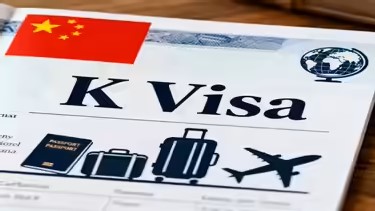China has announced the launch of a new K-visa, set to take effect from October 1, 2025, in a move designed to attract international professionals in science, technology, engineering, and entrepreneurship.
The initiative comes as countries increasingly use immigration policy as a tool in the global race for skilled talent. Unlike traditional work visas, the K-visa will not require applicants to secure a job offer or invitation from a Chinese employer before applying.
The new visa offers multiple entries, longer stays, and more flexibility than existing permits. It is specifically aimed at younger professionals with advanced degrees from top universities, as well as those with proven research or leadership experience in technology and innovation sectors.
Researchers, entrepreneurs, and innovators engaged in academic exchanges, joint projects, or business ventures are expected to benefit most. Chinese authorities have presented the policy as a step toward encouraging cross-border collaboration in science and technology.
Competing for Global STEM Talent
The timing of the visa aligns with China’s broader ambition to position itself as a leading hub for technology and innovation. Other countries, including the United States, Singapore, and members of the European Union, already operate similar visa schemes such as the O-1 visa, Tech.Pass, and Blue Card.
By simplifying the process and making entry more flexible, China is sending a signal that it wants to be seen as open to global expertise—even as geopolitical competition over innovation intensifies.
The new policy has clear potential. It could make China more attractive to skilled professionals who might otherwise struggle with restrictive visa systems elsewhere. It also reflects a shift from “brain drain” to what some observers call “brain circulation,” where talent moves more freely across borders.
Yet, there are hurdles. Language and cultural barriers remain significant, and questions linger about whether the K-visa could evolve into permanent residency pathways. Analysts also note that geopolitical tensions may deter some applicants, particularly from Western countries.
Why it Matters
The K-visa may carry special implications for the Global South, including Africa, where a growing number of graduates in STEM fields seek opportunities abroad. For many, China’s new visa could be an entry point into international research and entrepreneurship. But it also raises the familiar concern of brain drain, as local industries risk losing their brightest minds to more developed economies.
What China has introduced is more than just a visa. It is a strategic tool in the competition for knowledge and innovation. For aspiring tech professionals, it offers opportunity; for governments worldwide, it presents a challenge to rethink how to retain and attract talent.
The K-visa’s success will not be measured by the announcement itself but by how effectively it enables people to move, settle, and contribute in practice.
Talking Points
China is playing a long game. The launch of the K-visa is not just about visas—it’s about controlling the future of technology and innovation. By opening its doors to young, educated professionals, China is essentially fishing in the same pond where Africa desperately needs to keep its best and brightest.
Africa is at risk of becoming a talent donor. Let’s be blunt: while China is making it easier for innovators to relocate, African governments are still struggling with outdated education policies, poor research funding, and hostile startup ecosystems. If you are a young engineer in Lagos or Nairobi, the choice between staying home with limited opportunities or moving to Shanghai under a flexible visa is a no-brainer.
The global digital economy is a battlefield. This move by China highlights a global “talent war” where nations are weaponizing immigration policies to outcompete each other. Meanwhile, Africa is still arguing about whether to build tech hubs or how to regulate social media. That’s like bringing a knife to a drone fight.





